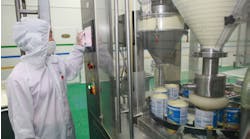Technical Director, Hapman
Selecting the right conveyor for a particular need is an important decision. Pneumatic conveying is often considered the standard solution for transferring materials in bulk solids plants. In many applications, however, a type of mechanical conveying using a tubular drag conveyor can be a more cost-effective solution. It also proves to be a top choice for difficult-to- handle and explosive materials.
The tubular drag conveyor consists of a tubular housing that encloses a continuous chain mounted with circular discs called flights. The flights are attached to the chain at regular intervals. The housing forms conveying and return legs that can be arranged in many configurations to suit specific applications similar to pneumatics.
Chemical Processing sat down with Eric Smith, Technical Director for Hapman, a global manufacturer of standard and custom bulk material handling equipment, to discuss best practices when moving hazardous and temperamental materials.
Q: Can you give a quick breakdown of the various conveying types that are suitable for challenging solids?
A: When we look at the material, we need to determine the best solution — can a flexible screw conveyor move it or could a pneumatic conveyor move it? But oftentimes with difficult materials, we have to use a tubular drag conveyor. And this type of conveyer operates in a low-speed, high-torqued operation. The low-speed operation of the conveyor greatly reduces the material degradation so it doesn’t break down as it’s being conveyed from the inlet to the outlet.
Q: What are considered difficult-to-handle materials?
A: Well, in general, materials are difficult when they are cohesive, they degrade easily, they can be highly abrasive or aerate. For example, one that has several of these characteristics is resin flakes.
Resin flakes become hard to handle in overheated conditions, whether by temperature or frictions, due to a low melting point. When this happens, the resin becomes adhesive, cohesive, and can pack and smear. A recent customer had pneumatic conveyors that created multiple issues with significant impact to profitability and efficiency of the system, and created an expensive explosion prevention issue. The high conveyance speed of pneumatics degraded materials, elevated temperature that caused plugging, and created multiple dusting issues. Due to the physics of the explosive material and how pneumatic systems work, expensive explosion suppression systems would have had to be installed and regularly maintained.
The tubular drag solution implemented solved all the above issues and significantly reduced operating costs through reduced maintenance, lower power consumption, while improving efficiency and up-time.
8-inch Tubular Drag Conveyor elevates product into hopper for packaging.
Q: Do you help facilities pick the proper conveyors?
A: Yes, we team up with customers and look at the materials they need to convey. A lot of other conveyors, they can tumble the material as it’s conveying, such as a screw conveyor. With pneumatic conveyors, there is high velocity — those speeds and that tumbling action break down the materials and the material can stick within those components. On a tubular drag conveyor, the material will come into the inlet and it sits between two plastic flights, typically made of UHMW [ultrahigh-molecular-weight polyethylene] and the material sits static between those flights and it moves through the system to the discharge point. Product captured between flights is moved en masse exposing it to very little turbulence during its transfer. Only a small percentage is ever in contact with the pipe wall minimizing the potential for abrasive degradation.
Q: Are there other special design considerations?
A: Many times when you get into a difficult-to-handle material and if it is explosive, you want to be dust-tight and odor-free. In the tubular drag, it’s totally enclosed, and it offers those things. With it being fully enclosed, we protect the workers from the hazardous dust, fumes and odors. Not to mention, the high torque operation of a tubular drag gives it the ability to stop and start under full load removing the need to handle the material once loaded into the conveyor.
Another great feature of the tubular drag is it can navigate around different objects. What has traditionally required two or three conveyors can often be accomplished with just one tubular drag conveyor. The ability to convey through bended pipe makes it possible to route conveyors through layouts requiring changes of direction.
Additionally, tubular drag conveys vertically. In crowded plant environments, the ability to convey vertically is a game changer. Suddenly retrofitting a vital new process into the middle of the plant is made possible by a conveyor that can receive material and immediately turn upward, conserving valuable floor space.
Q: What about NFPA guidelines?
A: Because we are moving the material at a low speed inside the conveyor and it’s sitting static between those flights, it generates very little dust. And with that, the dust is not explosive because it’s not present. With the NFPA guidelines, that is usually based on a volume calculation of how much material is sitting in a static place. And with the tubular drag, that calculation is done between flight pockets and that volume is a half a cubic foot or less per flight pocket.
Q: Is that measured all the time to make certain you are within the NFPA guidelines?
A: That is a calculation determined going into the application. That’s something we can define right up front. We can offer that volume calculation per flight and we can also tell customers how much material is in the entire conveyor.
Q: What mistakes can be made when selecting a conveyor system and what questions should customers be asking themselves?
A: A lot of it comes down to how does the material handle being moved? Can it break easily? Is it sticky? Can it stick to a conveyor flighting? What do we need for inlet agitation and devices to get it into the conveyor and how do we need to get it out of the conveyor?
With some of these hard-to-move materials, we do what’s called a snowball test. For the snowball test, you take a handful of material and you make a snowball with it. And if you open your hand and it free-flows back through your fingers, that’s a good application for a tubular drag. You won’t need any inlet agitation or discharge devices to get it off the chain. Now, if you open your hand and it sticks together but you can take another finger and poke at it and that starts to break apart, that tells us we probably need a vibrator on the discharge but still a good application for a tubular drag. But if you open your hand, you poke it and you leave an indent around it or it’s kind of like peanut butter and it’s stuck to your fingers, that’s not going to be a good application. At that point, you are going to want to look at a conveyor technology that can carry the material, such as a belt conveyor. Alternatively, if you can get that material dryer or wetter, sometimes that helps.
Q: And what about other materials? Can these same principles be applied?
A: The snowball test can be applied on any material. We work with sand, crystallines and powders — things that aerate.
What’s great is we can test materials at our in-house lab in Kalamazoo, Mich., to determine the best solutions.
Q: What suggestions do you have for those struggling to move their materials?
A: I suggest you get in contact with us and we’d be happy either to come out to your site and review the application or send material in and we can test it here. Start by providing information about your material’s characteristics, especially particle size, bulk density and flow properties. As a supplier, we will also need to know application details such as your plant’s available floor space and headroom, how your material will be stored prior to conveying, the distance your material will be conveyed, the available energy source, and similar information. A key part of this process is to have your material tested in a tubular drag conveyor in our lab. Based on the test results, we can help you determine which conveyor components and options are right for your application.
Q: Do you have anything you’d like to add?
A: The more hazardous the material, the more you’re going to want to keep it enclosed. A tubular drag conveyor is a great technology to do that in. Tubular drag technology is also very energy-efficient in comparison to pneumatic conveying, especially when the motive is an expensive utility, such as Nitrogen.
The design options with the tubular drag conveyor allow for integration into a new or existing material handling system and provide for long, reliable conveying operation.
For more information, visit: https://solutions.hapman.com/cp




